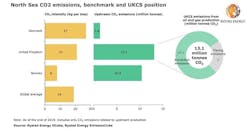Offshore staff
OSLO, Norway – Electrification of oil and gas platforms on the UK continental shelf (UKCS) has a key role to play in Britain achieving its 2050 net-zero emissions target, according to Rystad Energy.
Analysis suggests UK oil and gas production will remain significant, with a small decline over the next few years likely to be followed by output recovering to 2.09 MMboe by around 2035.
Emissions from oil and gas production in the UK totaled 13.1 MM metric tons (14.44 tons) of carbon dioxide (CO2), Rystad has calculated. Extraction emissions account for 10.1 MM metric tons (11.13 MM tons) of CO2, the rest due to flaring.
In comparison, Norway’s oil and gas production emissions last year were 4 MM metric tons (4.4 MM tons) of CO2 and Denmark’s 1.4 MM metric tons (1.58 MM tons).
In terms of emission intensity, the UK, at 21 kg of CO2 per boe is much higher than Norway’s 8 kg/boe, but lower than Denmark’s 27 kg/boe. The latter is said to reflecting Denmark’s low production levels compared to its infrastructure energy needs.
The global intensity average, Rystad added, is 19 kg of CO2/boe.
For the UK to attain its long-term climate goals, steps will have to be taken to electrify the offshore production infrastructure via renewable energy sources, the consultant said, moving away from the current reliance on carbon-intensive gas turbines and diesel generators on offshore platforms.
“Many operators and investors are now including an additional carbon cost in their capital allocation decisions,” said Rystad upstream analyst Olga Savenkova.
Offshore Norway, eight oil and gas fields operate partly or fully electrified with a further eight fields covered under sanctioned electrification projects. Rystad expects 60% of Norway’s production will come from electrified offshore platforms by 2025.
In the UK various oil companies are conducting feasibility studies for platform electrification schemes in the central North Sea and west of Shetland, and low-emission designs will become central to new field development plans.
However, there is a risk that high-carbon-intensity developments may struggle to comply with sanctioning requirements and that some UK late-life producing fields may face permanent shutdown earlier.
So, companies could be left with stranded assets if they do not act on emissions reductions, the consultant suggested.
Initial capital costs of renewable power generation schemes offshore will be higher than traditional power generation solutions, but this can be offset by lower operating costs and carbon price savings.
At the same time, taking power generation equipment off platforms will reduce topsides weight and manpower needs. Use of hydrocarbons on the fields should also be reduced, with no further need for power generation on mature assets.
Recently the UK government initiated a policy review of its future offshore oil and gas licensing regime, and this could lead to emissions-reduction obligations being incorporated into reviews of future license applications.
Another factor in the net zero target is carbon capture and storage, which, could cut 130 MM metric tons/yr (143 MM tons) from UK offshore emissions, according to the Oil and Gas Authority.
Finally, constructing offshore wind clusters close to offshore oil and gas production hubs could open the way to green electrification of production platforms.
In 2019, the UK’s share of global offshore wind installed capacity of 27.6 GW was 35% (9.7 GW), Rystad said.
The figure this year should rise to 10.4 GW with a surge to almost 38 GW predicted by 2030, close to the government’s target of 40 GW.
09/15/2020



